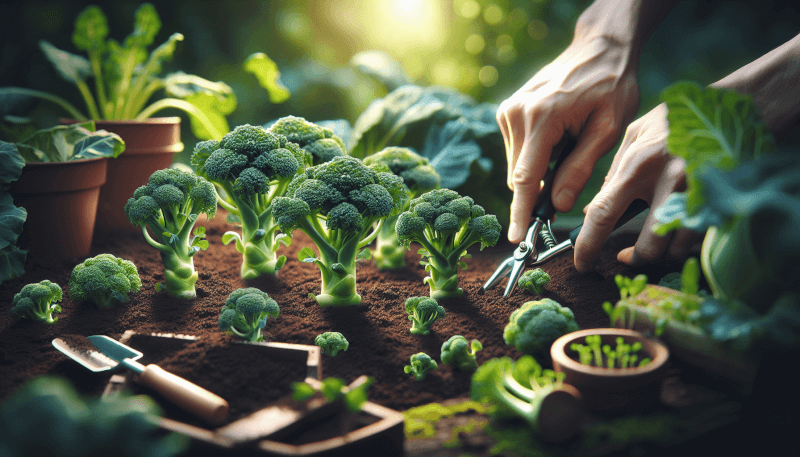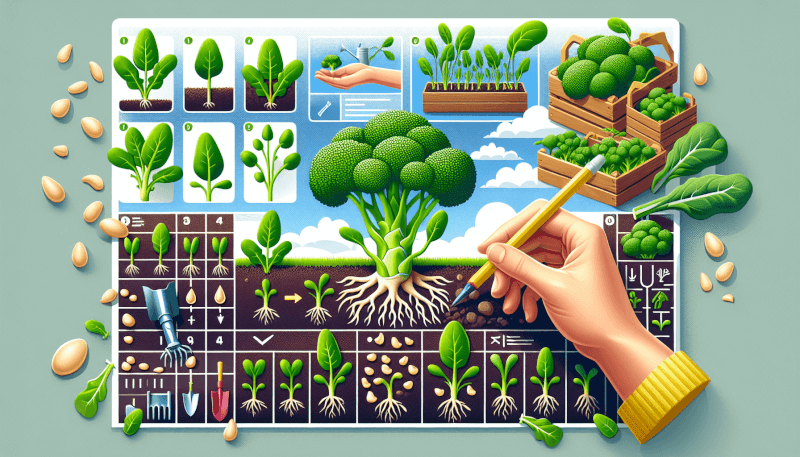👋 Click the mic button to talk to Alfred, the Todd's Seeds Gardening/Sprouting Expert – Feel free to ask him anything!
Ask Virtual Todd Anything - Click the Mic
Have you ever wondered how to grow broccoli sprouts in soil? Well, you’re in luck! In this article, we will guide you through the simple steps to successfully grow your own broccoli sprouts right in your backyard. With just a little bit of patience and care, you’ll be able to enjoy these crunchy and nutritious sprouts in no time. So, let’s get started and learn how to cultivate your very own broccoli sprouts in soil!
Choosing Broccoli Sprout Seeds
When it comes to growing broccoli sprouts, selecting high-quality seeds is crucial. Look for reputable seed suppliers or nurseries that specialize in vegetable seeds. Check for information on the seed packet or online about the seed’s origin, variety, and any special instructions. Opt for organic or non-GMO seeds if possible to ensure they are free from chemical treatments.
In addition to quality, it’s important to determine the suitable variety for your growing conditions and preferences. Consider factors such as the climate in your area, available space, and taste preferences. Some popular broccoli sprout varieties include De Cicco, Waltham 29, and Calabrese. Research the characteristics and growing requirements of each variety to make an informed decision.
Freshness is another important aspect to consider when choosing broccoli sprout seeds. Fresh seeds have a higher germination rate, which means they are more likely to successfully sprout. Check the seed packet for the harvest or expiration date to ensure you are purchasing fresh seeds. Additionally, inspect the seeds for any signs of damage or mold before purchasing.
Preparing the Soil
Preparing the soil is essential in providing a favorable environment for broccoli sprout growth. Start by choosing the right location for your sprouts. Broccoli sprouts thrive in full sun with at least 6-8 hours of direct sunlight per day. Ensure the chosen location has well-draining soil to prevent waterlogging and root rot.
Before sowing the seeds, clear the area of any weeds or debris. Weeds can compete with the sprouts for nutrients and space, hindering their growth. Remove any rocks, sticks, or other debris that may impede seedling emergence.
Testing the soil pH is a crucial step in preparing the soil for broccoli sprouts. Broccoli thrives in slightly acidic to neutral soil, with a pH range of 6.0 to 7.0. A soil testing kit or pH meter can be used to determine the current pH level. If the soil is too acidic (lower than 6.0), lime can be added to raise the pH. Conversely, if the soil is too alkaline (higher than 7.0), sulfur or other acidifying agents can be used to lower the pH.
Amending the soil with organic matter is beneficial in improving its structure and fertility. Adding compost or well-rotted manure helps to enrich the soil with essential nutrients and improve its water-holding capacity. Work the amendments into the top few inches of soil, ensuring they are evenly distributed.

Sowing Broccoli Sprout Seeds
Creating rows or beds is a common method for sowing broccoli sprout seeds. Prepare the rows or beds by loosening the soil with a garden fork or a tiller. Aim for a depth of around 1 inch, keeping in mind the specific planting instructions provided on the seed packet.
Sow the broccoli sprout seeds according to the recommended spacing, which is typically around 12-18 inches apart for rows or 24-36 inches apart for raised beds. Place the seeds at the appropriate depth, usually about 1/4 to 1/2 inch in the soil.
Cover the seeds with soil and gently firm it down to ensure good seed-to-soil contact. Water the seeds immediately after sowing to provide them with the necessary moisture for germination. Regularly monitor the soil moisture and add water as needed to keep the soil consistently moist but not waterlogged.
Providing Optimal Growing Conditions
Broccoli sprouts require certain conditions to thrive and produce a bountiful harvest. Adequate sunlight is crucial for their growth and development. Ensure the sprouts receive at least 6-8 hours of direct sunlight daily by placing them in a sunny location or using reflective materials to maximize sunlight exposure.
Maintaining proper temperature is also important for optimal broccoli sprout growth. Broccoli sprouts prefer moderate temperatures between 65-75°F (18-24°C). Avoid exposing them to extreme heat or cold, as it can inhibit their growth and lead to poor performance.
Proper drainage is essential for preventing waterlogged soil, which can cause root rot and other issues. Ensure that the planting area has sufficient drainage or consider planting in raised beds or containers with drainage holes. Avoid overwatering as it can suffocate the roots and promote diseases.
Watering is a crucial aspect of providing optimal growing conditions for broccoli sprouts. Keep the soil consistently moist but not saturated. Water deeply, allowing the water to reach the root zone, and avoid overhead watering, as it can promote fungal diseases. Monitor the soil moisture regularly and adjust the watering frequency based on weather conditions and the moisture needs of the plants.

Caring for Broccoli Sprouts
Thinning the seedlings is an important step to ensure proper spacing and healthy growth. Once the seedlings reach a few inches in height, thin them by removing the weaker or overcrowded sprouts. Maintain a spacing of around 12-18 inches between plants to provide adequate room for growth and airflow.
Fertilizing the plants is essential for supplying them with the necessary nutrients. Apply a balanced organic fertilizer according to the package instructions or conduct a soil test to determine any specific nutrient deficiencies. Avoid over-fertilizing, as it can lead to excessive leaf growth and poor quality sprouts.
Mulching around the plants can help retain moisture and suppress weed growth. Apply a layer of organic mulch, such as straw or shredded leaves, around the base of the plants. This will help conserve soil moisture, prevent weed competition, and provide insulation to the root zone.
Protecting broccoli sprouts from pests and diseases is crucial for a successful harvest. Common pests that affect broccoli sprouts include aphids, cabbage worms, and flea beetles. Monitor the plants regularly and take appropriate measures such as using organic pest control methods or introducing beneficial insects to manage pest populations.
Supporting the plants as they grow can help prevent damage from wind or heavy rainfall. Install stakes or cages around the plants to provide support and prevent them from falling over. This is especially important as the plants mature and develop heavy heads.
Harvesting Broccoli Sprouts
To ensure optimal timing for harvesting, monitor the growth and maturity of the sprouts. Broccoli sprouts are typically ready for harvest when the heads reach a desired size. Harvesting too early may result in small sprouts, while waiting too long can lead to over-mature sprouts with a tough texture and bitter taste.
When ready to harvest, use a sharp knife or pruning shears to cut the sprouts properly. Cut the main stem just above the sprouts, ensuring to leave a few inches of stem attached to each sprout. This allows for smaller side shoots to develop and provides the potential for a secondary harvest.
Storing and Using Broccoli Sprouts
For storing freshly harvested sprouts, it’s best to consume them as soon as possible to enjoy their maximum freshness and flavor. If needed, store them in a plastic bag or airtight container in the refrigerator to extend their shelf life. However, keep in mind that broccoli sprouts are best when consumed within a few days of harvesting.
If you have an abundance of sprouts, they can be preserved by freezing. Blanch the sprouts in boiling water for a couple of minutes, then quickly cool them in ice water. Drain the sprouts and store them in freezer-safe containers or bags. Frozen sprouts can be added directly to soups, stir-fries, or other cooked dishes.
Incorporating broccoli sprouts into meals and recipes is a great way to enjoy their health benefits. Add them to salads, sandwiches, wraps, or smoothies to boost their nutritional value. They can also be lightly steamed or sautéed as a side dish or added to stir-fries for a flavorful crunch.
Common Problems and Solutions
Broccoli sprouts may face various challenges, including pests, diseases, nutrient deficiencies, and environmental stress. Common pests affecting broccoli sprouts include aphids, which can be targeted with insecticidal soap or neem oil. Cabbage worms can be controlled with organic insecticides or by handpicking them off the plants. Flea beetles can be controlled by using row covers or applying diatomaceous earth.
Identifying and treating diseases promptly is important in preventing their spread and minimizing damage to the plants. Common broccoli sprout diseases include clubroot, downy mildew, and black rot. Fungicides or cultural practices such as proper spacing and good air circulation can help manage these diseases.
Addressing nutrient deficiencies is crucial for promoting healthy growth and maximizing sprout production. Conduct a soil test to identify any specific nutrient deficiencies and adjust the fertilizer application accordingly. For example, yellowing leaves may indicate a nitrogen deficiency, which can be remedied by applying a nitrogen-rich fertilizer.
Environmental stress can include factors such as extreme temperatures, drought, or poor soil conditions. Providing appropriate shading or using shade cloth can help protect the sprouts from excessive heat. Regularly monitor the soil moisture levels and irrigate accordingly to prevent drought stress.
Tips for Successful Broccoli Sprout Growing
Selecting the right time for sowing is important for optimal broccoli sprout growth. Sow the seeds during the appropriate season, considering the average last frost date in your area. Broccoli sprouts prefer cooler temperatures, so sowing in early spring or late summer can provide the ideal conditions.
Maintaining consistent moisture levels is crucial for broccoli sprouts, as fluctuations in soil moisture can lead to stress and poor growth. Monitor the soil moisture regularly and water deeply when needed to keep the soil consistently moist but not waterlogged.
Providing adequate spacing between plants ensures they have enough room to grow and receive sufficient airflow. Proper spacing minimizes the risk of disease and allows each plant to access the necessary sunlight, water, and nutrients.
Regularly inspecting and monitoring the plants helps identify any issues early on, allowing for prompt intervention and prevention of further damage. Regular checks for pests, diseases, nutrient deficiencies, and environmental stress will help ensure the health and productivity of your broccoli sprouts.
Benefits and Nutritional Value of Broccoli Sprouts
Broccoli sprouts offer a plethora of health benefits due to their nutritional composition. They are rich in vitamins, minerals, and antioxidants, making them a nutrient-dense addition to your diet. These sprouts are packed with vitamins C, K, and A, as well as folate and fiber.
In addition to essential vitamins and minerals, broccoli sprouts contain potent antioxidants, such as sulforaphane and glucosinolate compounds. These compounds have been linked to potential antioxidant and anti-inflammatory properties, which may have a positive impact on overall health and disease prevention.
Including broccoli sprouts in your diet can support a healthy immune system, promote detoxification, and contribute to heart health. They can be enjoyed raw or lightly cooked to maximize their nutritional value. Incorporate them into your meals as a tasty and nutritious way to boost your well-being.
In conclusion, growing broccoli sprouts in soil requires careful consideration of seed selection, soil preparation, sowing techniques, and providing optimal growing conditions. Thinning the seedlings, fertilizing the plants, and protecting them from pests and diseases are essential steps in caring for broccoli sprouts. Harvesting the sprouts at the right time and properly storing and incorporating them into meals help maximize their freshness and nutritional benefits. By following the tips and guidelines outlined in this article, you can successfully grow and enjoy the nutritious goodness of homegrown broccoli sprouts.